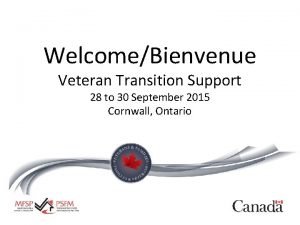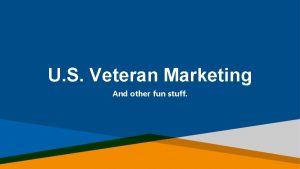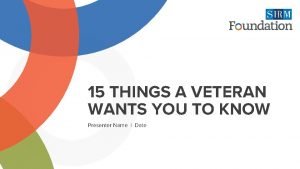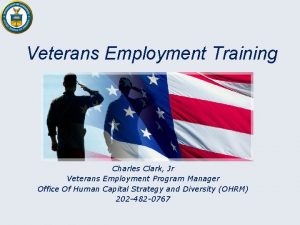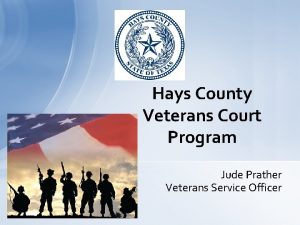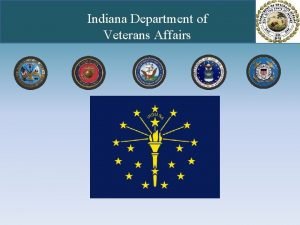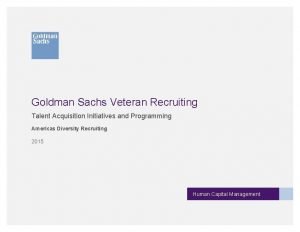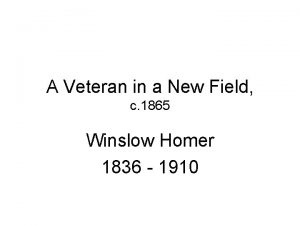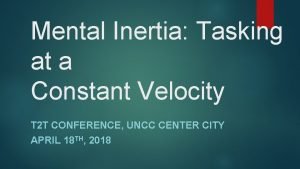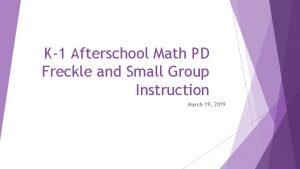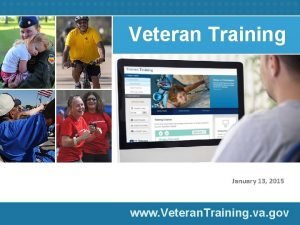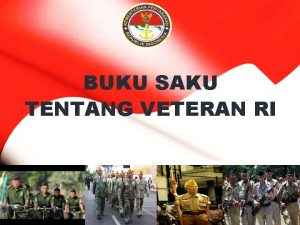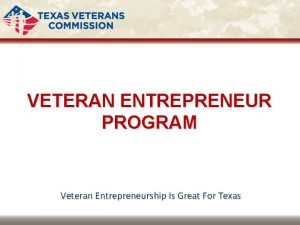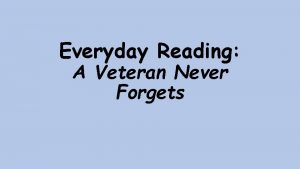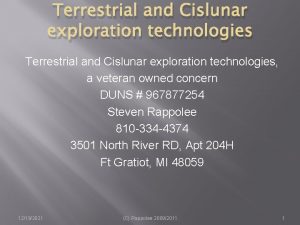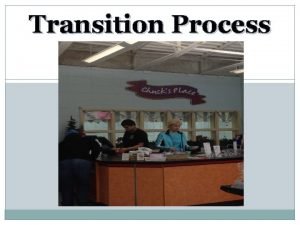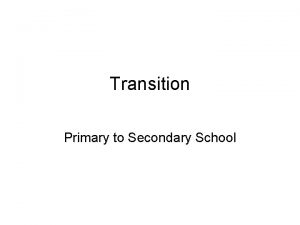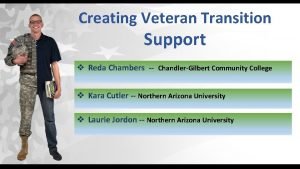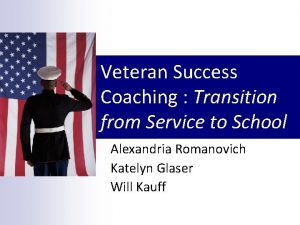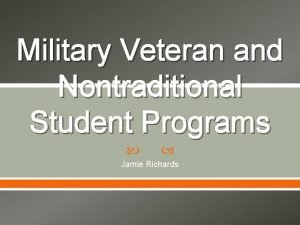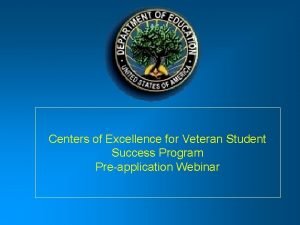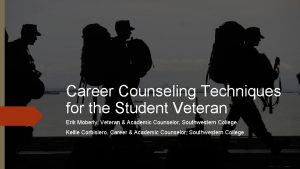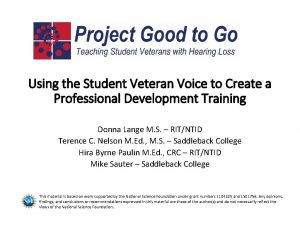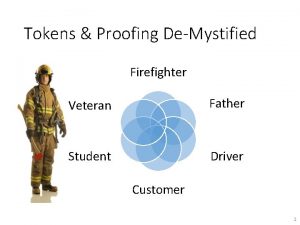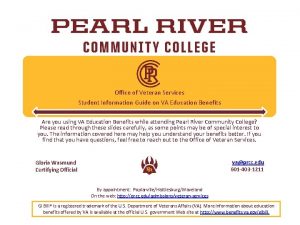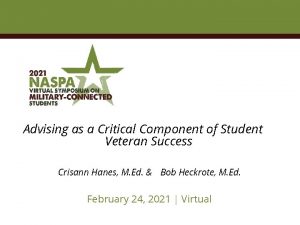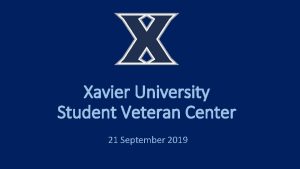An Exploration of Student Veteran Transition from the
























- Slides: 24

An Exploration of Student Veteran Transition from the Military to a Two. Year Community College and their Perception of Support Services and Veteran Programs by Dr. Dawn H. Mackiewicz

Introduction This interpretative phenomenological analysis (IPA) examined the experiences of student veterans who were either graduates or in their last semester in a two-year community college in Massachusetts. It probed the question: How do student veterans’ who utilize support services at a two-year community college in Massachusetts perceive and explain the value of these services in regards to their retention?

Background and Context Zhang (2017) reported that in 2015, 2. 7 million veterans returned from active duty and by 2016, 790, 000 veterans utilized their Post-9/11 educational benefits; therefore, two-year community colleges should consider various methods to accommodate the influx of veterans returning to college. Student Veteran needs differ from traditional students. The transition from military to civilian life entails barriers for some student veterans The pressures of family, work , and attending college. The student veteran must attend full time to gain the full benefit of the Post-9/11 education bill Viewing themselves as more mature than traditional students Some reluctance to seeking support services

Theoretical Framework Schlossberg (1981) Model

Theory Schlossberg’s (1981) 4 S Model Situation- This part of the model was useful in understanding each participants situation. Self- Was helpful in understanding how the student veteran viewed their success and how support services have met their needs. Support- This was most important as the participants were able to identify limitations of personnel and the need for a veterans center. Strategy- The participants were able to provide some substantial recommendations on how two-year community colleges can engage veterans by offering various external and internal supports.

Research Design: Methodology Interpretative Phenomenological Analysis -Participant selection and how the researcher can to some extent remove previous assumptions, carefully take notation , and adhere to rigorous interpretation (Donalek, 2004) Clancy (2013) focused on how IPA would the particular experience – a phenomenon. Finlay (2014) explained by using IPA would allow the researcher could to create an exchange with the participants. Shinebourne (2011) referred to Husserl and his contributions to this strategy of inquiry and for the researcher to understand the lived experience of the participants in the study.

Research Design: Study Site The researcher originally selected a single two-year community college in a suburban setting in Massachusetts. The research site had faced some difficulty in obtaining participants. Consequently, the researcher was required to amend the IRB application to attain additional participants for the research study. College One College Two College Three Degrees/ Certificates 32/15 37/22 34/18 Student Veterans 220 260/70 307 % of Post-9/11 benefits used 85% 73% 62% No One full time advisor Yes 2 part time advisors Existence of a Yes Veterans Center Part-time advisor

Research Design: Participants Smith (2009) stated that using a small sample pool can strengthen the level of engagement between the researcher and the participant in gathering vital information. Ø Purposeful Sampling Ø Graduated or in their last semester Ø Served in Iraq or Afghanistan Ø One Female participant/Five Males Ø One obtained their associate’s degree Ø Two completed their bachelor’s degree Ø Two student veterans were in their last semester Ø One obtained their master’s degree

Research Design: Data Collection 20 to 25 minute initial interviews 45 to 60 minute indepth interviews Interviews recorded and later transcribed using REV. COM Sharing of transcripts with participants

Findings: Eight Themes Transition from Military to College life The complexities of applying for Post-9/11 Benefits • Initially seeking employment • Used fellow military peers • Coping with the transition from structured environment to a flexible one. • A majority found it relatively difficult • Dealing with PTSD • Time consuming The use of support services • GPA often measured whether or not they would consider seeking assistance. • Affirmed the value of support services if needed, but many focused on counseling, some on tutoring.

Findings: Themes The existence or non-existence of a Veterans Center • Student veterans created a veterans club • One participant who was a certifying official used his office as an ad hoc center • This space was needed to decompress, feel safe and connect with other veterans Faculty support and accessibility • Accessible to all students • Sensitive to veterans’ needs • One participant was wary of the possibility of political views/antiwar and military attitudes affecting grading Traditional student integration • Student veterans could not relate because of the maturity level differences • Traditional students were not able to identify with them. • The need for separate services and orientation

Findings: Themes Veterans advisor • Limitations financially for full time position • Counseling essential • Post-911 educational benefits • Adequate training and support for advisor Veteran Friendliness • Need for a veterans center • Acceptance and response to needs • Training on PTSD

Theme 1: The transition from military to college life 1. Student veterans explained the difficulty of transition and some reported having to cope with PTSD before consideration of attending college. 2. The student veteran initially engaged in full-time employment and later used their Post-9/11 benefits because they could see the need for a formal education. My backpack's heavier than yours every single day, you know. So, we got to try to figure out a way to lighten the load of that backpack

Theme 2: The complexities of applying for Post 9/11 educational benefits 1. Some of the student veterans found the process of applying for Post-911 educational benefits time consuming and a little complex. All participants used a peer military friend to apply for the benefit. 2. Student veterans who were eligible for financial aid were not made aware of their ability to apply by the institution in which they were enrolled. “I believe at the time the VONAPP, which is Veterans On-Line Application websites, did exist. But it was not userfriendly, ah, at all. ”

Theme 3: The use of support services 1. The participants reported that they measured their needs for academic supports by their individual GPA. 2. The participants clearly recognized the need for support services, however, only 4 of the 6 participants used some form of support services. “Statistics I struggled in. I didn't…I missed the - the memo where I was supposed to get one of those fancy- fancy schmancy calculators. “ “So I was trying to do all these calculations just on paper and what not with just a regular calculator. And, uh, it went poorly for… after about the third or fourth week. And I ended up having to go to the- the math tutor. “

Theme 4: The existence or non-existence of a Veterans Center 1. The participants viewed the existence of a veterans’ center as a way to measure “veteran friendliness” on the part of the institution. 2. The veterans center can be used to provide supports, as well as become a place where veterans can share experiences with other veterans. “You’re checking up on our platoon mates, so it is incredibly helpful to me on a personal level and it builds a trust because we all have been through so much as soldiers. ” “Absolutely. I feel that the veterans should have their own spot on campus, have the veteran's advisor share their knowledge at the veterans’ center. ”

Theme 5: Faculty accessibility and support 1. A two-year community college whose faculty members are accessible to the student veteran, create a safe classroom environment, and allow them to seek assistance. 2. The importance of faculty in understanding veteran issues such as PTSD and other issues provides an atmosphere of safety and non-judgmental behaviors can enhance the student veterans’ ability to persist. “They've all been great. If I tell them, "Hey, I can't come in, because of this or because of that as long as I get a valid reason and its related and practical, they're pretty easy on me”

Theme 6: Traditional students and veteran integration 1. The participants were not opposed to any form of collaboration in the classroom with traditional students, however, they recognized the major differences of the two populations and their ability to relate. 2. The student veteran viewed themselves are more mature than the traditional students. “But that's like, you know, a, a, a 40 -year-old man trying to explain his retirement run to a 20 -year-old person. It just doesn't work. “

Theme 7: The Veterans Advisor 1. A two-year community college that recognizes the need to hire a dedicated veterans’ advisor to support student veterans in both educational benefits and internal and external supports can comprehensively assist the veteran in their overall success in college. 2. Hiring a knowledgeable veteran advisor/certifying official who can keep apprised of any legislative changes regarding Post 9/11 educational benefit is important. “That [the educational benefits advisor position] is…at the very least a part-time job and it's very most a full-time job. “ “Yeah. She was there to help me pick out my classes, let me know what I could and couldn't take, what the rules of the Post 9/11 GI Bill [were] and how it worked. ”

Theme 8: Veteran Friendliness 1. Two-year community colleges that want to respond fully to student veteran needs can begin by recognizing what unique services can enhance their ability to persist. 2. Understanding PTSD, the ability to provide outside veteran supports, and overall demonstrating commitment to this population were essential to veteran friendliness. “There definitely didn't seem to be any- any hostility or indifference towards me at all. ” “It would be great if the Upward Bound program was there. It is limited to a couple different colleges. ” He continued by saying, “That program is amazing in that it's something that every veteran, anyone with veteran status can go and use and those guys will set you up for success all day long. ”

Implications for Practice Develop a Virtual Veterans Center to meet the needs of those veterans who have difficulty assessing the center. Hire a full –time certifying official to meet the needs of the student veterans Create a survey instrument to share.

Recommendation One: Virtual Veterans Center Virtual Weekly Workshops: Veteran Student Login On-line counselor/veteran advisor support • Financial Planning • Veteran educational benefit • Financial Planning • Coping with PTSD • Career and Resume Building • Other workshops as recommended by the veterans. • Mental Health Counseling • Referrals to veteran agencies • Post-9/11 Educational Benefit assistance

Recommendation Two: Distribution of a Survey Instrument • Workshops • Identify the need • Online or face to face communication • Measuring and evaluating the veterans advisor • The use of a virtual Veterans Center • Improvements of the current center Needs Measurement Understanding Implementation • Faculty member accessibility • Assessing the level of “Veteran Friendliness”

Breakout Session What resources do you think higher educational institutions should incorporate to meet the needs of student veterans? Would a virtual veterans’ center enhance services for this population? What barriers do you face in your daily work in providing adequate services to student veterans? Could you list four resources that the institution could provide that could assist student veterans’ in their transition?
 Veteran transition academy
Veteran transition academy Veteran market segmentation
Veteran market segmentation 15 things every veteran wants you to know
15 things every veteran wants you to know Veteran employment opportunity act
Veteran employment opportunity act Hays county district clerk
Hays county district clerk Indiana veteran license plate
Indiana veteran license plate Goldman sachs veterans
Goldman sachs veterans Weyth
Weyth Student exploration: moment of inertia
Student exploration: moment of inertia National student clearinghouse student tracker
National student clearinghouse student tracker Sls moe learning space
Sls moe learning space Class maths student student1 class student string name
Class maths student student1 class student string name How's your last weekend
How's your last weekend National student clearinghouse student tracker
National student clearinghouse student tracker What did they do last weekend
What did they do last weekend Good morning, students.
Good morning, students. Https://student.freckle.com/#/login
Https://student.freckle.com/#/login Bổ thể
Bổ thể Từ ngữ thể hiện lòng nhân hậu
Từ ngữ thể hiện lòng nhân hậu Tư thế ngồi viết
Tư thế ngồi viết Giọng cùng tên là
Giọng cùng tên là Thể thơ truyền thống
Thể thơ truyền thống Chúa yêu trần thế
Chúa yêu trần thế Khi nào hổ con có thể sống độc lập
Khi nào hổ con có thể sống độc lập đại từ thay thế
đại từ thay thế
